More Than a Billion Hopes: Will India’s promise of growth and development be delivered or derailed?
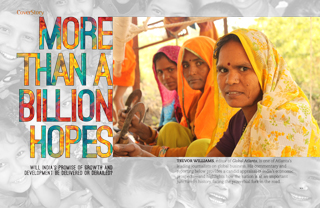
TREVOR WILLIAMS, editor of Global Atlanta, is one of Atlanta’s leading journalists on global business. His commentary and reporting below provides a candid appraisal of India’s economic prospects—and highlights how the nation is at an important juncture in history, facing the proverbial fork in the road…
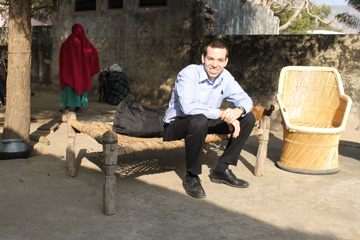
The author, Trevor Williams, has made several reporting trips to China, and one to India in 2012. He is seen here at a roadside tea stall in Narhat, Rajasthan.
I arrived in Jaipur without any expectations. I’d scarcely heard of the Rajasthan capital, but the sights that awaited me were even more striking than bustling Mumbai, where I’d landed in 2012 on my first and only reporting trip to India.
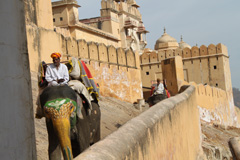
Ancient glories, and modern woes...where will it land India? Seen here is an elephant carrying tourists up the Amer Fort, Rajasthan. (Photo: Trevor Williams)
Jaipur’s sandstone architecture and the array of breathtaking palaces set the stage for the allure of the city. Elephants with brightly painted heads labored uphill to deliver tourists to the splendid and (for me) otherworldly Amer Fort. Jewelers and cobblers sold their wares beneath pink and orange colonnades. Snake charmers with entrancing tunes proved that the iconic old India is still well and alive. A gilded wedding took over my hotel that first evening in this colorful city.
While endearing and exotic, these were just the opening acts, the preliminary pointers to the deeper experiences that sealed my impressions of India’s promise: interactions with the people.

A home-based weaver crafting a rug for Jaipur Rugs. (Photo: Trevor Williams)
My two days in the city would be packed. I would eat—shoes removed—in the home of N.K. Chaudhary, CEO of Jaipur Rugs, where I learned more about his decentralized model of manufacturing. He would arrange for me a visit to a village where his company employs home-based weavers who craft rugs by hand.
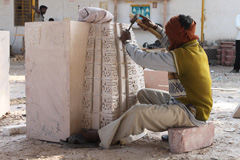
An artisan transforms limestone blocks into ornate carvings of gods and spiritual symbols, that are then numbered and shipped across oceans—to be reassembled as giant 3D jigsaw puzzles that end up becoming majestic BAPS Swaminarayan Temples, such as the glorious one in Lilburn, Georgia. (Photo: Trevor Williams)
Later, I would travel outside the city to see artisans clinking away with chisels and saws to transform limestone blocks into ornate carvings of gods and spiritual symbols. These would be numbered and shipped across oceans—to be reassembled as giant 3D jigsaw puzzles that end up becoming majestic BAPS Swaminarayan Temples, such as the glorious one in Lilburn, Georgia.
But it was a simple, unplanned moment where the promise of the country crystallized, where its pragmatism seemed to overshadow all its obvious problems.
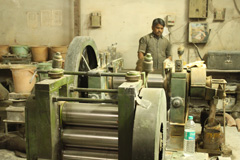
Workers craft prosthetic limbs at Jaipur Foot, a nonprofit that acts as a cross between an outpatient therapy center and a rudimentary factory. (Photo: Trevor Williams)
On a whim, we visited Jaipur Foot, a nonprofit that acts as a cross between an outpatient therapy center and a rudimentary factory. Amputees wandered the grounds and sat waiting to be fitted with prosthetic limbs. Behind the main building was a factory where a few workers (ill-equipped by American safety standards) melted and blended plastics to pour into molds for artificial limbs. Others bent, shaped, welded, and painted metal bars into bright yellow tricycles powered by hand for those who had lost their legs.
Back inside, we found an entire room’s attention fixed on a man who had just strapped on a new arm. A glass of water now fixed in his rigid artificial hand, he struggled to take a drink, visibly laboring to complete what is a simple task to most. There were murmurs of cheers when the glass reached his lips.
That’s the thing with India.
Visiting for the first time, most
people point out that it’s a land of contrasts. What they usually mean is that it’s a place where you can see a top-of-the-line Mercedes-Benz speed past a crippled beggar, then weave around a cow on the road, passing modern buildings rising next to the direst of slums.
But for me, it wasn’t just the surface-level manifestations of economic disparity inside the country; it was the gap between its raw promise and its ability to inject itself into the modern global economy. India seemed so paradoxical. At the grassroots, it was a land of unending possibilities, where the concept of jugaad (frugal innovation) flourished amid stifling bureaucracy and official malaise. It was a place where a way could always be found with the right connections and effort, where “No” was less of a dead end and more of a challenge—where limbs can be restored for just a few dollars.
This was the country with the largest rail network in the world, where a society of dabbawalas deliver hundreds of thousands of homemade lunches per day in Mumbai without the benefit of logistics software, where 600 million people vote in the world’s largest democratic elections, where some 200 million were enrolled within a few years in a national biometric data system, where the Kumbh Mela spiritual festival draws tens of millions over a month’s time. This is a country of big things.
It’s also the world’s back office, a source for more than 100,000 of its brightest students coming into the U.S. each year, the leading sender of skilled-workers in the U.S. It’s a place where world-class heart surgery can be had for a fraction of U.S. prices and where drug makers can churn out vaccines and generics that save lives all over the world.
So, why in my reporting did it always seem like India was falling short compared to other emerging markets? Why did the country always seem to have a chip on its shoulder? Why did its diaspora, so entrepreneurial and successful in places like the United States and United Kingdom, have to shake their heads when looking back home? Why did foreign companies so excited about India often run aground on antiquated laws and market nuances?
If Indians could thrive within India, despite its countless hurdles, why was the world’s second-largest nation failing to perform at its potential in the inter-national system?
And when would that change—if ever?
The waning of the Modi euphoria
In 2014 came a watershed moment for efforts to rewrite this narrative. The Bharatiya Janata Party (BJP) won a landslide victory in national elections, handing the Prime Minister’s position to Narendra Modi, who had run a presidential-style campaign hinging largely on his own personality and buoyed by the promise of “Achche din” (better days to come), based on his successful record in transforming the economy of Gujarat, when he was chief minister of the state.
Modi’s BJP gained control of the lower house of Parliament, marking the first time ever that one party had achieved such a mandate at the national level in India’s frothy democracy.
But into this second year of his office, the national euphoria surrounding Modi has mellowed. There is concern that the Modi mandate might not be as bulletproof as once thought.
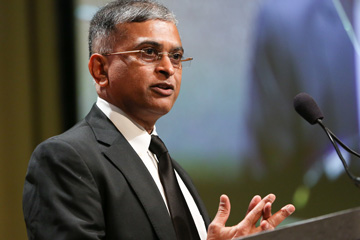
India is posting a GDP growth rate of 7.4 percent, and that’s with the “brakes on,” notes C.N. Madhusudan, CEO of Atlanta-based VectorSpan, which handles mergers and acquisitions dealing with Indian companies.
“There was really a lot of excitement around that ‘It’s possible now,’ and that’s been the big disappointment, I think because important bills ... are stuck by political trouble,” C.N. Madhusudan, CEO of Atlanta-based VectorSpan, which handles mergers and acquisitions dealing with Indian companies, said about this dramatic reversal of the national mood.

Alyssa Ayres, senior fellow for India, Pakistan, and South Asia at the Council on Foreign Relations pointed to announcements like Taiwan-based Foxconn’s decision to locate a $5 billion plant in India and Ford Motor’s plans for a huge factory for domestic production as signs that sentiment is prevailing even where substance has failed.
Parliament ended its most recent session in December without move- ment on the GST (Goods and Services Tax), a plan to end interstate levies in favor of a national taxation system that would remove barriers to trade across states. Another concern is the political gamesmanship that could stand in the way of consensus needed in a coalition government. Alyssa Ayres, senior fellow for India, Pakistan, and South Asia at the Council on Foreign Relations, pointed to a court case brought against Congress leaders Sonia Gandhi and her son Rahul Gandhi by a prominent member of the BJP, which is threatening to make relations across the aisle even more fractious. November elections in Bihar, a state of 100 million people where the BJP lost power, have underscored this feeling.
Continued Optimism…
But some India watchers believe the
disappointment is a symptom of the fact that hopes for Modi’s first year were always too high, especially from foreign investors eager to see a highly protectionist market of 1.2 billion people flung open overnight. “I always thought people had unrealistic expectations. Particularly internationally,
people thought that India would stop
being India and that it would be immediate transformational change. That wasn’t the case,” said Ayres.
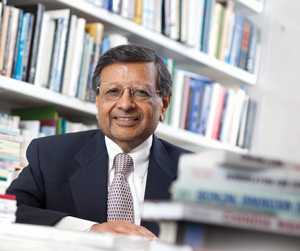
Jagdish Sheth, an Emory University marketing guru and author of Chindia Rising, echoes the same when he points out that foreign investors are voting with their feet by stepping up their stakes in India despite vocal concerns about the country’s business environment.
And the discontent among business leaders in India is sometimes higher than their foreign counterparts, said Jagdish Sheth, an Emory University marketing guru and author of Chindia Rising, who added that foreign investors are voting with their feet despite vocal concerns about the country’s business environment, which sits at No. 130 in the World Bank’s Doing Business rankings.
“Several nations have already significantly increased their investment in India including Russia, Japan, and South Korea as well as individual countries in the European Union. Also, waiting in the wings is China, which would like to invest in India across several sectors of the economy including consumer electronics, appliances, and cell phones,” Sheth wrote in an email from India. “In my view, even in the U.S. which has expressed more concerns and a cautious mindset about India, there is a growing interest in the defense sector and digital technologies. In fact, a significant level of research and development in pharmaceuticals and digital technology has already shifted to India.” He is also bullish on India’s prospects as a destination for outsourcing of professional services including accounting, legal, and tax services.
Ayres pointed to announcements like Taiwan-based Foxconn’s decision to locate a $5 billion plant in India and Ford Motor’s plans for a huge factory for domestic production and export in Modi’s home state of Gujarat as signs that sentiment is prevailing even where substance has failed.
Modi’s first year was marked with substantial reforms often overlooked by those who sought to see more progress, she said. He is credited for bringing in discipline in notoriously lax standards of government bureaucracies, and for promoting digitization to help ordinary citizens avail of government services without resorting to bribing. He used ordinances, equivalent to executive orders in the U.S., to bring about change. He raised the cap on foreign investment in the insurance sector to 49 percent, an achievement that had eluded previous governments for a decade. He’s also focused on the basics: cleanliness in cities and toilets in the countryside, speaking candidly on the fact that kids have a hard time studying when they have nowhere to go to the bathroom.
And there has been a marked shift in how India approaches the world, some say. Modi has instructed diplomatic offices to prioritize investment recruitment, an unheard-of proposition for his predecessor, Manmohan Singh, who some called the “disappearing prime minister” and whose govern- ment was in power during a raft of corruption scandals that shook confidence in government.
“What Modi has done which has been a little bit different from previous governments is get out there and pitch India commercially, and that is a different approach,” Ayres said, adding that India has started to revive rhetoric about its unique role in the world, its ancient culture, and its storied history as a trading nation.

“Realism has dawned, and that realism is that we are on the right path,” said Consul General Nagesh Singh, in an interview last year, regarding India’s prospects with PM Narendra Modi at the helm.
Even members of the diplomatic corps point to a shift in mindset. Nagesh Singh, India’s consul general in Atlanta, agreed that while overplayed in the short run, the Modi hype underscores a real change in the way people feel about opportunity in India. “Realism has dawned, and that realism is that we are on the right path,” Singh told me in a Global Atlanta interview after his arrival in Atlanta last year.
Now, India “has a window of opportunity to either make the necessary reforms or risk being left behind. ‘It will have to decide whether it wants to become a major part of global trade flows and deeply integrated into global supply chains. Doing so would boost India’s efforts to grow its manufacturing sector and its economy; choosing not to will make that ambition harder to achieve,’” Ayres and others on a CFR task force wrote recently in a note that said India could follow China in becoming the world’s next $10 trillion economy (up from about $2 trillion now.)
Move Over, China
Much of the urgency underpinning these discussions is driven by the looming presence of India’s overachieving rival and neighbor, whose success over the past three decades has brought
India’s shortcomings into acute focus.
But there are signs that its run of Asian dominance is coming to an end. China’s leaders now talk of a “new normal” of slower target growth rates around 7 percent, more driven by consumer activity and services than manufacturing and investment. India, meanwhile, is posting a GDP growth rate of 7.4 percent, and that’s with the “brakes on,” said Madhusudan.

Emory University Professor Jeffrey Rosensweig notes that India has a beautiful, bell-shaped demographic curve—heavy on the bottom, thanks to a young population that will form a large labor pool and a customer base for companies in the future.
These trends make India look even more promising. For one, as Emory University Professor Jeffrey Rosensweig said in a recent rundown of emerging economies, the country has a beautiful, bell-shaped demographic curve—heavy on the bottom, thanks to a young population that will form a large labor pool and a customer base for companies in the future. China, meanwhile, is getting older, and the recent relaxation of its one-child policy is too little, too late to avert this trend, some experts say.
China is also getting more expensive in terms of land, labor, and logistics. Not only will India get some overflow manufacturing as global companies diversify, but it could also benefit as a wealthier China begins to procure its business and technology services, Sheth said. Putting border disputes in the Himalayas aside, Modi and Xi Jinping have warmed to one another recently, with China announcing some $20 billion in investment in the country after their last meeting.
In nine trips to China and years reading about the country and reporting on it, I’ve seen cracks in the top-down model that has facilitated its growth but has led to questions about the sustainability of that achievement. Many have written about a “grand bargain” between the people and the ruling Communist Party: an upward trend line toward prosperity in exchange for reduced political freedom. While that arrangement has created an economic miracle, it has also fostered a climate of distrust, especially as President Xi has cracked down on graft in officialdom in the name of enhancing the rule of law. The moneyed masses are leaving China in droves, parking assets abroad in investor-visa schemes like the EB-5 in the United States. Recent numbers show record numbers of Chinese students in the U.S., with enrollment at American high schools and middle schools also climbing.
Still, while the country is far from wealthy across the board, you’d be hard-pressed to find slums in Chinese cities, and its achievements in reducing poverty are undeniable. “State capitalism,” in which the Communist regime presides over a limited market economy, is working, at least from that standpoint. Of course, China’s state-owned firms need massive overhauls, but homegrown giants (aided by government protection and capital) are spreading their wings in technology and other sectors around the world, competing with global players and seeking acquisitions.
India, conversely, has faced what some might call the cost of democracy. While China forcibly relocates people and cultural relics to build massive infrastructure projects like the Three Gorges Dam, India protects the rights of squatters on private land, often to the frustration of big development projects. While China’s government sets its own ambitious top-down agenda that provincial leaders must follow, Indian states pursue their own plans in a country whose diversity, culturally and from a regulatory perspective, makes it more akin to the European Union than the United States. China’s courts may be opaque, but get into a dispute in India and it could drag on for decades.
If you keep score, India seems not to be doing that well. Some 900 million people still lack access to the Internet—a staggering number. Some 600 million people lack toilets, and about 300 million live on less than a dollar a day. The middle class, while substantial and growing, is small relative to the broader population.
But much of India’s economic dynamism—and its future hope—bubbles up from the lowest rungs of society, from previously disenfranchised people who are just starting to get plugged into the economy through mobile phones and the Internet. A low base means India has a long runway for growth into the future, while some say China’s aging population means it’s more likely destined for the path of Japan—lightning-fast industrialization followed by a period of stagnation, marked labor shortages, and expensive elder-care bills.
“In the long run, say 15 to 20 years out, India will have both market and resource advantages over China. In fact, the same nations that made China the world’s factory will slowly but surely shift manufacturing to India, despite all the infrastructure and governance issues,” Sheth said. “Let’s remember that in the late ‘70s, China did not have good infrastructure nor did it have any Western governance system for finance, banking, and legal contracts. It was a very poor state-led communist economy. China was made by non-Chinese manufacturers.”
Who’s Going to Make It in India?
If the same is to happen in India, though, big changes are needed. In contrast to China, where governments dole out land in industrial parks to foreign companies on the promise of substantial investments, India’s arcane land laws are a huge headwind for industrial development and real estate investment.
I saw that in Mumbai while visiting a friend’s father, whose family owns a shabby residential building near the Gateway of India. Over afternoon tea, he outlined for me the painstaking process by which he was gaining residents’ approval over a period of years for the sale of the building. A developer would eventually pay millions for a consolidated tract of land, but current residents were holding out to get a guaranteed place in the new building. (That same process was outlined in Last Man in Tower, an Aravind Adiga novel I reviewed last year.)
Labor is also a major issue, with complex restrictions making it nearly impossible to fire people once companies reach a certain employment threshold. The Confederation of Indian Industries has noted that this has led to a vibrant micro, small, and medium enterprise sector but has hindered companies’ ability to scale up.
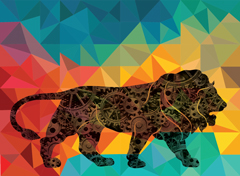
Modi hopes to change at least some of that with the Make in India campaign, which spotlights the country as a manufacturing destination and includes concrete measures to boost competitiveness and burnish India’s reputation.

Scott Ellyson, whose Atlanta-based company, East West Manufacturing, is still trying to figure out whether India will be worth the investment it started nearly three years ago. Amongst the reasons he cites for his lack of optimism: His Indian partners haggle over everything, including contracts and prices that have already been fixed. They fail to communicate, even through email. They inject a sense of gamesmanship that slows things down.
Those haven’t come soon enough for Scott Ellyson, whose Atlanta-based company, East West Manufacturing, is still trying to figure out whether India will be worth the investment it started nearly three years ago.
East West’s joint-venture motor factory in China and wholly owned factories in Vietnam have been categorical successes. In India, the path to growth— or even to a break-even point—has been murkier since the company set up an office in Chennai to source components in metals and rubber, sectors where India is considered to be a global leader.
Ellyson blames part of the problem on his own strategy: not having enough business in place before it went in. But he’s also frustrated with the Indian business culture. Accustomed to bureaucracy, his partners haggle over everything, including contracts and prices that have already been fixed. They fail to communicate, even through email. They inject a sense of gamesmanship that slows things down. That’s a stark contrast with China or Vietnam, where partners are more responsive, he says.
Logistics can be painfully slow— with a shipping container taking two weeks to get to a factory and then two weeks to get back out of the port. “If I had to put the No. 1 complaint, it’s just lack of speed. There’s just this sense of urgency that seems to be missing,” Ellyson says. He’s open to success proving him wrong, but he’s not optimistic that what he sees as ingrained habits will change anytime soon.
Perhaps it’s a matter of cultural nuances or growing pains, as some Indians here in the U.S. say manufacturing in India has been eminently achievable with the right partners. State governments, in fact, are now competing with each other for foreign business, relaxing their own regulations and setting up special economic zones to welcome outside companies.
In a recent event in Atlanta, manufacturing executive Mahendra Srivastava talked about opening one of the world’s largest candle factories, Primacy Industries, with ease in the city of Mangalore. Abhay Paranjape of Lockheed- Martin says the defense contractor is making fuselages in India with the aerospace unit of the Tata conglomerate. Even the real estate sector shows a lot of promise: Atlanta’s Portman Holdings is investing heavily in India through partnerships with established players who understand the lay of the land—and hold titles to it. “My view is that one has to focus on the opportunities and solve the challenges,” said Ambrish Baisiwala, the company’s Indian-born CEO.
Soul Searching
While it’s a time of optimism, Indian
society isn’t without its ills. Violence
against women continues to be a highprofile
issue, highlighted by the case
of a Delhi gang rape and murder that
captured national attention for months
in 2012. Concerns that he is tacitly encouraging
intolerance against Muslims
have dogged Modi’s Hindu nationalist
BJP. Hindu extremists have dragged
people from their homes over eating
beef, which is prohibited by law in many
states. Sex-selective abortion is stubbornly
high, corruption is pervasive, and
environmental degradation is increasing
as growth accelerates.
The question is whether the loud discussion over all this simply indicates a country dealing with its challenges, or whether it could boil over into political polarization that ultimately derails the economic momentum Modi has kickstarted.
It may slow things down at times, but democracy is a non-negotiable in India that many agree strengthens the country’s long-term economic prospects, Madhusudan said.
“A river finds its way around boulders and sand. It just flows. Has it been blocked? No, it has not been blocked. Has the speed of the flow been reduced? Yes. But it’s still flowing because the quantum is so much. It’s the sheer size,” he says.
I asked Vikas Swarup, the Indian diplomat who wrote Q&A, the book that would be adapted to the Oscarwinning film Slumdog Millionnaire, what he makes of the very real challenges he portrays vividly in multiple novels on his home country, which have earned him criticisms.
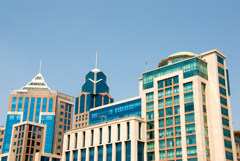
Existing in a couple of centuries at the same time, India is not “easily encapsulated,” says the writer and diplomat Vikas Swarup. Will India’s optimism see it through?
India, he says, is not easily encapsulated. “Because we are a nation of a billion people, it means we are a nation of a billion stories, and because of the sheer diversity, you have the India living in 17th century and the India living in the 22nd century,” he said in an interview before speaking at Emory University last year, adding that it’s the former who persuade him of India’s long-term promise.
“There are people you will see who have not even a scrap of clothing on their body, yet the guy has a smile on his face because he believes his tomorrow will be better than his today. That’s what impresses people about India, that people can have such an optimistic view of life despite living in depressing, dehumanizing conditions.”
end680.jpg)
Trevor Williams is the managing editor of Global Atlanta, an international business news source that frequently covers India’s ties with the Southeast U.S. Follow Trevor on Twitter: @jtrevorwilliams.
Enjoyed reading Khabar magazine? Subscribe to Khabar and get a full digital copy of this Indian-American community magazine.
blog comments powered by Disqus










